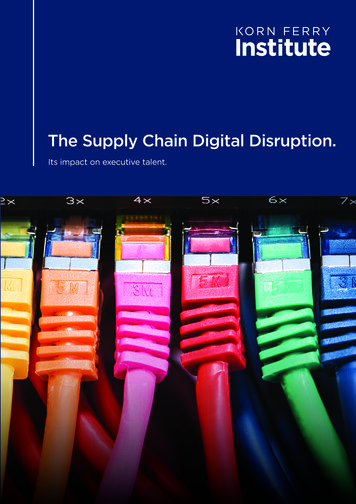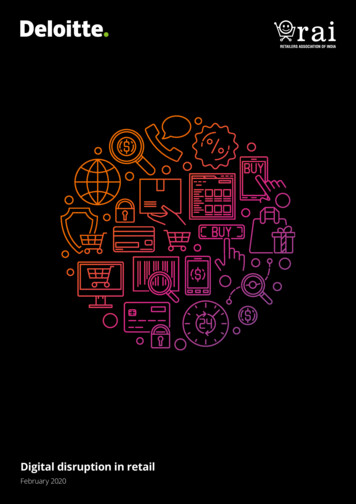
Transcription
The Supply Chain Digital Disruption.Its impact on executive talent.
The Supply Chain Digital Disruption Executive SummaryAcross all industries—from consumer goods tohealth care, manufacturing to financial services—more companies are “going digital.” Digitisation is verymuch at the forefront of any CEO’s mind. Predictionsare that every company and virtually every job will betouched and most likely transformed or eliminated bydigital innovation. For supply chains to fulfil their fulldigital potential companies need to connect disparatesystems, provide end to end visibility, capture andanalyse massive amounts of data. The availabilityof advanced analytics and affordable cloud-basedtechnologies allows companies to go beyond theimprovement of service levels and cost reduction.Historically over the last 30 years, the supply chainhas undergone a tremendous change. What was oncea purely operational logistics function that reportedto sales or manufacturing and focused on ensuringsupply of production lines and delivery to customershas become an independent supply chain managementfunction that in some companies is already being ledby a CSCO—a chief supply chain officer. The focus ofthe supply chain management function has shiftedto advanced planning processes, such as analyticaldemand planning or integrated sales and operationsplanning (S&OP), which have become establishedbusiness processes in many companies, whileoperational logistics has often been outsourced tothird-party logistics providers. The supply chainfunction ensures that operations are well-integrated,from suppliers through to customers, with decisionson cost, inventory, and customer service made froman end-to-end perspective rather than by each functionin isolation.2Digitisation creates a disruption and requirescompanies to rethink the way they design their supplychain. At the same time, customer expectations aregrowing. The online-enabled transparency and easyaccess to a multitude of options regarding where toshop and what to buy drive the competition of supplychains. This does not only apply to B2C but also B2Bcompanies.More and more data will become available, RFIDsensors, for example, track and manage in-storereplenishments increasing on shelf availability, enablingdirect delivery to stores, driving sales up and deliverycosts down, increasing the retailer’s profitability.A study by The Boston Consulting Group shows thatthe leaders in digital supply chain management areenjoying increases in product availability of up to 10percentage points, more than 25% faster responsetimes to changes in market demand, and 30%better realization of working-capital reductions, onaverage, than the laggards. They have 40% to 110%higher operating margins and 17% to 64% fewer cashconversion days. With the help of three key strategies,these agile companies are quickly leaving behind theirless nimble competitors.The general consensus is that companies cannotafford to wait and the leaders in digital supply chainmanagement are building a financial advantage thatwill be more difficult to overcome with each passingyear. Companies will need to map opportunities foreach of the newly available technologies. BCG forexample have defined the landscape of digital supplychain management and developed a map of the majorareas of activity.
The Supply Chain Digital Disruption The landscape of digital supply chain management.AdvancedanalyticsCloudcomputingControl tivediagnosticsPlanning merplatformsWarehouse Geoanalyticsoperations based networkautomation optimization3-DprintingSupply Chain roductiontechniquesLogisticsInternetof ted realityand simulationDigital application areasSupporting technologiesTalent ImplicationsHowever, in order to deliver its potential, the function isbeing driven to transform, and there is increased pressureon the talent who are expected to deliver this change.The war for supply chain talent to drive digitaltransformation is further intensifying. The war spans allindustries and is at the forefront of most CEO’s agendas.With digital disruption changing markets everywhere,top executives around the world are changing theirpriorities. Korn Ferry International surveyed 100 seniorsupply chain executives, along with interviewingacademics and consultants, to explore issues that leadersface and their approach to building and organising therequired talent to support this transformation. Morethan half of the respondents (53 percent) had a formalposition to lead digital supply chain management, withmost (92 percent) reporting to a COO, Chief Supply3Chain Officer (CSCO), or to a supply chainleadership member.“The Supply Chain Digital Disruption” aims toprovide some insights, particularly from a talentperspective, on the contexts, visions, and challengesof supply chain leaders facing the loomingimplications of digitisation, as well as suggesting aframework for building capability and culture andaddressing a target operating model to respond tothe challenges ahead. The executives were asked fortheir views on three main issues:nnnThe impact and context of digitisation intheir businessTheir capability building and the availabilityof digital talentTheir biggest challenges in the coming yearsand how they intend to meet them
The Supply Chain Digital Disruption Their answers in this report provide many revealinginsights, with four themes in particular standing outthat are detailed below. It is clear that supply chain isnot ready from a talent perspective for the impendingtransformation, and leaders of the function will needto learn what it means to lead in the digital world.To what extent are companies armed with talent forthe supply chain digitisation? Digital technology hasdemonstrated its capacity to augment existing systemsand improve productivity and has started to have majorimpact in the creation of new business models. What thismeans for supply chain leaders and the talent required inthe future is unclear for companies of all sizes and scalesof complexity. This report explores the current statusof companies’ digital strategy, existing talent base, androadmap for the future.4
The Supply Chain Digital Disruption Key InsightsThe data gathered from Korn Ferry’s survey of 100supply chain executives highlighted four key themes:Digitalisation Unfulfilled1. Digitisation is highly relevant for supply chainmanagement, with three-quarters (74 percent) ofexecutives rating this as 4 or 5 out of 5.None of the executives we interviewed raised anydoubt about the immense potential of a digitisedsupply chain to provide the highest possible value tothe customer while minimising cost. This, in turn, willhave a revolutionary effect on the workforce. Thepositive impact of digital technology on the supplychain is widespread, with three-quarters of respondentsrating digitisation as highly relevant or imperative forsupply chain management. “Digitisation could redefinethe entire business model and strategy,” said JanetGodsell, University of Warwick’s professor of operationsand supply chain strategy at WMG. “It has the potentialto be revolutionary.” Indeed, McKinsey projected that“the biggest future impact [of digital] on revenue andEBIT growth is set to occur through the digitisation ofsupply chains.” The function is expected to developgreater flexibility, lower cost and risk, and even developnew ways of analysing its potential revenue impact.“We will have different enablers, so the systems needto evolve and change. In terms of service (includinglost sales), there is the possibility of a 90 percentimprovement. We have much better forecasting, whichtranslates into more targeted supply chains,” saidKnut Alicke, master expert in McKinsey’s Supply ChainManagement practice, about the impact of better datain improving execution. “With respect to warehousingand transport, there is a 20 to 40 percent improvement5possible. We expect supply chain administration(planning and order management) will be automatedfrom 60 to 80 percent as master data is more reliable; weexpect a big impact on inventory through better planningand 3D printing, which could slice inventory in half.”Diverse opportunities are being explored in everyindustry: food retail businesses consider the futureimplications of printing food; pharmaceutical companiesput sensors in medicine bottles to meet regulatoryrequirements to track drugs throughout the supply chain;global consumer goods businesses are evolving intoomni-channel to deliver direct to consumers; and thirdparty logistics (3PL) businesses are investing in robots,increasing big data, and using wearable technology toincrease the accuracy of picking in their warehouses.Disruptive companies such as Amazon continue toexpand and threaten established businesses, including3PL providers. Indeed, one of the largest freightforwarding businesses views Amazon as its biggestthreat. Business models are being fundamentallyre-created, with companies that previously had B2Bbusiness models having the potential to become B2B2C.In fact, digital disruption will cause an entire supplychain mindset shift: “There will be a change of KeyPerformance Indicators (KPIs) in the future. Many oftoday’s supply chain indicators such as ‘On Time, In Full(OTIF)’ will be obsolete. In the longer term when lookingat revenues (which before we couldn’t calculate) theKPI will change,” said Carlos Gordon, Lego Professorof Strategy and Supply Chain Management at IMD.“Supply chain needs to try to understand and substitutethe KPIs to show the impact on profits and sales. Therewill be a huge learning curve on how we adapt to newmeasurements.”
The Supply Chain Digital Disruption 2. About three-quarters (74 percent) of executivespositioned themselves in the middle of the scale ofadvancement, saying that a start had been made onDigitisation, but there was still a way to go.Most executives surveyed and interviewed admittedthey were at the exploratory stage, and it is evidentfrom our research that there is a discrepancy betweenthe anticipated importance and impact of digitalizationand work that has been done so far. None of the seniorexecutives surveyed indicated that their supply chainwas fully digitised, suggesting that their businesses arenot well enough prepared for the challenges to come.While three-quarters of the executives stated thatDigitisation had begun, about half (48 percent) of thosesurveyed advised us that their strategy only considersthe impact of Digitisation on the business, and lessthan a third (28 percent) had a strategy redesigned fordigital integration or was digitally native.These findings suggest that Digitisation of the supplychain has yet to deliver game changing impact.Despite the fact that three out of four executives ratedDigitisation as highly relevant or imperative for supplychain management, only two out of three executivesindicated they had seen significant improvement intheir supply chains to date. At the same time, two outof three executives responded that service will be mostheavily impacted by Digitisation (over inventory andcost).Korn Ferry’s research suggested that the biggestbarrier to digital transformation was the lack of a digitalstrategy, and lack of digital talent was a close second,offering an explanation for the marginal improvementseen to date (see Figure 1). This was caused in turn bya lack of investment in this area, with 88 percent ofexecutives stating that less than 20 percent of theirlearning and development budget was being spent ondeveloping Digitisation capabilities.A respondent to our survey offered an interestingexplanation for the lack of clear strategy: “The missingcapability is understanding of supply chain at boardlevel. Supply chain is seen as cost down, whereaswe should see it as a new revenue model generator.Everything comes back to the leadership challenge;why are we failing to get the right leadership at the top?”asked Professor Godsell. “UK boards are dominatedby commercial and financial backgrounds, and even ifyou change the gender and ethnic mix, this does notovercome every angle of the lack of diversity. ChiefSupply Chain Officers are a relatively new addition tothe executive board, but are not usually on the mainboard at the top table.”In addition to the leadership and strategy issue, whenreflecting on the challenges of building digital capabilityin the supply chain, many of our interviewees felt thatdigital supply chain experts are hard to find, and can behard to attract. Generation Y is considered easily bored,meaning its members could be hard to retain if notgiven new challenges regularly.Figure 1.What are the main barriers when it comes to digitising the supply chain? (can choose more than one)Lack of cleardigital strategyAvailability ofdigital talentLack of topmanagement supportRigidity of governance/organisationMissinganalytics toolsNumber of Responses605101520253035
The Supply Chain Digital Disruption 3. About four in 10 of those surveyed (41 percent)said a key barrier to digitising the supply chainwas the availability of digital talent.Two out of three executives with whom we spoke builtdigital capability in their organisations through hiring,with about half of those doing so by hiring consultantsor by “hiring from companies that are more digitallyadvanced” (See Figure 2). About one out of five hiredfrom universities and research organisations, whileother respondents told us they leveraged learningdevelopment tools through internal training of existingemployees to improve their foothold in digital talent.Despite the acknowledged importance of the digitisedsupply chain, the financial commitment to developingthe required skills is low, with nearly two out of threeorganisations allocating less than 10 percent of theirL&D budget to digitisation, and about the same numberof executives admitting that it was not enough. At thesame time, three out of four respondents said they hadnot formally assessed the digitisation readiness of supplychain employees, and roughly half had no plans to do so.Undoubtedly the impact on talent will be huge; smaller,more educated workforces need to be organised in moreagile ways to respond to changing supply chain KPIs(revenues, not just cost). The war for talent is increasing,and supply chain leaders and HR business partnersfor supply chain must take an active role in attracting,developing, organising, and rewarding supply chainexecutives in innovative ways.“In ten years, we will be looking at a supply chain that isbeing driven by digital, by supply chain simulation thatcan predict what needs to happen, where infrastructureshould be built, and where products should beshipped from,” said Prasad Srinivasamurphy, presidentof BXBDigital, Brambles. “In the future, this will bedone through technology, rather than through tribalknowledge. If you look at a lot of supply chains today,they are run through people’s knowledge. We need tofocus more on customer needs, letting technology runsupply chain.”However, while there will be a transition towards asmaller, more educated, and technologically savvyworkforce in the future, “digital transformation is aboutbringing people in, not just out, but those that staywill require a more agile, flexible approach,” said DirkHolbach, corporate senior vice president and CSCO,laundry and home care, and managing director atHenkel Global Supply Chain B.V. “The implication is thatpeople will cost more. The equation is positive to paymore for fewer people.”Figure 2.How do you build and develop digital capabilities the supply chain? (can choose more than one)Internal trainingExternal trainingConsultancyHiring people with digitalbackground/digital capabilitiesOtherNumber of Responses705101520253035404550
The Supply Chain Digital Disruption 4. A third of executives surveyed had organized digitaltalent as a centre of expertise or some form of unitin the supply chain function, and the reasons for thisare apparent from an attraction, retention, and culturalshift perspective.While about a third of the organisations we spoke toorganised their digital talent into a centre of expertise(CoE), roughly one in four had decentralised talent acrossthe supply chain function. About half of respondentsidentified technical skills, such as analytics and bigdata, as the main gaps within their organization; lack ofstrategic and user-experience skills was also prevalent.“E-commerce businesses such as Amazon have thedata scientists to plan better, creating innovationopportunity, which allows them to lead in this space,”said Knut Alicke. “GE has their Silicon Valley incubator.Vodafone has cognitive procurement, a department thatpushes these topics. Kellogg’s funds a couple of startups, and then integrates them if they are promising There’s not a single best-practice approach yet—peopleare experimenting and there are several ways of doingthat: a digital taskforce; classical project teams; internaldevelopment; or a small venture-capital fund where theysecond people to a start-up funded by the company; ifsuccessful they buy it back.”The supply chain leaders we interviewed supportedAlicke’s view. Brambles has a standalone digital businessunit, which its leader, Prasad Srinivasamurphy, sees“as a game changer” for the business. He built a teamin Silicon Valley and Bangalore focused on bringing intechnical capability. “I’ve taken a broad holistic view ofwhat needs to be done instead of looking narrow, and havestarted to engage with customers on what opportunitiesthey see for themselves, and how Brambles can enablethem,” he said.“I hope in the future we will have a mindset that everyfunction in the supply chain is primarily focused on digital,”said Mark Tusveld, Senior Director, Global Supply Chain forDigital, at Nike. “My organisation is an incubator, so you8want people out in the organisation as well. Whilethere still might be a central team setting the strategy,deployment will need to move into the functions.”These CoEs or digital units allow for a different cultureto exist within an organisation. It allows a rare failfast mentality that thrives in digital environmentsbut often fails in traditional corporate organisations.Some companies are setting up their digital labsin separate buildings that imitate a Google-styleworking environment to attract digital talent. In thesesub-cultures, digital pilots are incubated, tested, andallowed to fail quickly or be implemented if successful.“We [supply chain executives] are very good atplanning, doing things well, and looking at bestpractice models, but digital is about testing, whichcomes with success and failure,” said ProfessorGordon. “Born digital cultures such as Amazon aremuch more adventurous with teams empowered tomake changes. [The] dilemma in supply chain is thatwe are perfectionists, but perfectionism goes againstSilicon Valley.”Korn Ferry research has shown the difference inpersonality traits between leaders in “born digital”organisations, and those leading a “going digital”effort (see Figure 3), and our interviews furthersupport the cultural challenge of integrating advanceddigital talent into traditional businesses undergoingtransformation. “Born digital” leaders have deepdigital expertise and can develop a radically differentdigital solution to an activity (e.g., a sales transaction)whereas “going digital” leaders can help influence thebroader organisations to develop and evolve existingways of doing business to leverage digital technology(e.g., by automating parts of the existing supply chain).
The Supply Chain Digital Disruption Figure 3.9
The Supply Chain Digital Disruption With a lack of clarity about talent needs and hiring, thereis a related disconnect between supply chain and the HRfunction, with only about one in four survey respondentssuggesting they were closely aligned. Three out of fourrespondents said their organisations lack a clearly definedsuccess profile for digital transformation of supply chainleaders, with many leaders suggesting that “we don’t knowhow to improve our level of digitisation in supply chain.”With a clear skills gap in digital technology, acknowledgedunder-investment in L&D in this space, and limited intentionto assess digital readiness, there is a significant role for HRto play in driving the digital transformation of supply chain.People, organisation, and the role of HR indigital transformationDigital requires new organisational models (to supportnew business models), new people, and a shift in culture.HR needs to take on a strategic role in close partnershipwith the wider business to help these shifts occur.What form do some of these interventions take?Figure 4.10Recruiting and developing digital talentFor an organisation to “go digital,” there is a varietyof talent that needs to be in place. Figure 4 belowshows the segmentation of leadership talent thatKorn Ferry typically assesses and develops. There aretwo axes. The digital axis shows the level of digitalexpertise required to undertake a role in the futureorganisation. The transformation axis looks at thedegree to which leadership is involved in businessas usual (and incremental improvement) as againsttransforming operations.HR, drawing on appropriate assessment tools, canthen support the business in three ways:1. Assess the type of talent that is required tosupport the future operating model (typesand numbers of talent in the four quadrants)2. Assess the current talent—against the differing“success profiles” for these four quadrants3. Recruit and develop the talent to matchthe demand identified in the first tape
The Supply Chain Digital Disruption Supporting an innovative, digital cultureWhile there is no single “digital culture,” the fastmoving pace of digital innovation does thrive betterin a supportive culture. Employers like Google andAmazon are characterised by a freedom to experiment,low “power distance” between leaders and staff, andresources (time and money) to try out new ideas. HRcan play a supportive role in developing these types ofculture in many ways including:nnnDiagnosing the current culture—and the enablersand blockers to innovation—using tools such asthe cultural diagnostics to develop action plansCreating environments in which innovation developsbest, where innovation is actively rewarded(through awards, recognition, and bonuses) andtaking risks is something that staff are activelymeasured positively againstExperimenting with policies such as “10% time”where a proportion of employee time can be spenton innovating alongside concepts such as “scrumteams” or “tribes” where informal groups developnew approachesFurther support from HR may come inother forms such as:nnn11Supporting organisational and business modelredesign to facilitate integration of differentsales channels or new digitally enabled serviceor supply chain processesEnabling innovation via performance managementagainst new measuresEnsuring new behaviours and efforts are suitablyrecognized by means of reward and compensation
The Supply Chain Digital Disruption The pragmatic approachto digitally disruptingyour supply chainA Q&A with Prith BanerjeePrith Banerjee recently joined Korn Ferry as a SeniorClient Partner for the Global Industrial Practice. Beforethat he was Chief Technology Officer at ABB andSchneider Electric, where he oversaw large scale digitaltransformations. Banerjee lays out the top opportunities—and steps—leaders should take as they journey from afocus on logistics to a holistic digital supply chain.What defines digital transformation?The idea behind digital transformation is using technologyto radically improve the performance and the reach ofenterprises. The technologies themselves are varied:cloud computing, mobile applications, the Internet ofThings, social networks, Big Data and analytics, machinelearning and artificial intelligence, 3D printing, roboticprocess automation, augmented reality and virtual reality,and the block chain.Why should the CEO care about all of this?It can help drive top-line revenue, either through newbusiness models or an extension of products and servicesAnd on the cost-saving side, there’s improving operationalefficiency or improving the employee, customer, andsupplier experience. They have access to all the dataand their life can become easier.In your role, what are your top tips for yourChief Supply Chain OfficerA CSCO needs to adopt digital technologies such asCloud, Mobile, IOT, or AI/ML not because they are cooland new, but because it can significantly impact thebusiness outcomes in the supply chain. Some examplebusiness outcomes may be reducing the manufacturing12cost, reducing the time to produce a product, theability to integrate supply chains with the suppliers toreduce inventory, and improving the quality/reducingdefects of your products, and the ability to track andtrace root causes early as soon as defects are identified.As a leader, you should not try to boil the ocean andtry to embrace all digital technologies and solve allbusiness outcomes at the same time, but instead:1) Test Simple Things. Get early wins to win the supportof your stakeholders, and the morale of your team.2) Evaluate the talent of your supply chain workforcein the new digital world. Your team members must havethe talent and skills to embrace this digital technologyand get the maximum out of it. Your people right nowmay not have those skills. The people, in general, needto be more agile.3) As a leader, always be curious and agile in yourmindset. Empower your team to take risks, try newideas, fail fast and fail often, but learn quickly fromthese failures, and adapt your approach in the newdigital world.
The Supply Chain Digital Disruption Looking AheadOver the past 10 years, supply chain has transformedfrom back office to strategic enabler with theability to create competitive advantage in a muchmore strategic way. Whilst supply chain leaders areincreasingly represented at the executive board levelin several industries, there still remains a lack at themost strategic or highest governance level, withfew non-executives on main boards bringing thisinsight. Even companies that embrace the value ofan effective and sufficient supply chain often stickwith incremental changes rather than choosing ahigh-risk/high-reward transformation towards a trulyintegrated, re-invented supply chain whose DNA isfundamentally digital. Most organisations are weldingdigital capabilities onto traditional supply chains, thuscreating hybrid models with additional complexity.In effect, these organizations are trying to constructnew buildings on old foundations: re-fitting, re-wiring,and re-adapting instead of re-inventing, but the cardsare stacked against them in the long run. The lowrate of supply-chain digitisation to date has muchto do with the capabilities of the technologies thatcompanies have had available until recently.Real digital transformations—as opposed to digitaladd-ons—are a huge challenge. However, the potentialgrowth and profit-enhancement opportunities thatdigital technologies offer are even larger. Some argueit will be an evolution rather than a revolution but noone disagrees that the pace of digitisation will increaseas cross-industry initiatives aim to better connectsupply chains among companies to achieve next levelcost and delivery speed optimisation. The degree oftransformation for supply chains will depend on theindustry sector and company.13McKinsey observes that most of the disparitybetween potential and actual gains from supply chaindigitisation can be explained by technology gaps andpoor management choices. However, now that betterdigital solutions have become available, companies canmake greater and faster improvements in supply-chainperformance. Korn Ferry argues that digitally enabledsupply chains have new talent requirements that arequite different in many ways from those of conventionalsupply chains. A critical mass of selected supply chainmanagers will need to be able to translate their businessneeds into relevant digital applications leveraging allnew technologies at hand. The integration and effectivedeployment of data scientists into a traditional workforcerequires a cultural shift. This requires a new breed ofsupply chain leader who is able not only to develop aroad map planning several years ahead but can alsocorrectly gauge the ease of implementing changes,partly because technology is continually improving atrapid speed. What is impractical today might becomean obvious solution in a years’ time.Digital transformation needs are being driven fromthe top, personally mandated by the CEO. This appliesalso to the supply chain. A supply chain leader whocannot get the CEO’s ear, however technically savvy, haslittle chance to meet the challenges ahead. This calls fora new type of supply chain leader, the digitally savvyCSCO who is both a trend spotter and resource provider(see below).
The Supply Chain Digital Disruption Who is the future chief supply chain officer (CSCO)?It has been argued for some time that the modern chief supply chain officer needs to think like aCEO, foster collaboration, have excellent communication skills, and be a strategic relationship builder.As the focus turns to digital transformation, what does a digitally savvy CSCO need to bring overand above these demands? As digital technology is reshaping supply chains, the CSCO’s role keepsevolving. Fundamental drivers such as hyper-customisation and customer-centricity are calling fora new type of executive who thinks beyond supply-and-demand networks
position to lead digital supply chain management, with most (92 percent) reporting to a COO, Chief Supply Chain Officer (CSCO), or to a supply chain leadership member. "The Supply Chain Digital Disruption" aims to provide some insights, particularly from a talent perspective, on the contexts, visions, and challenges










